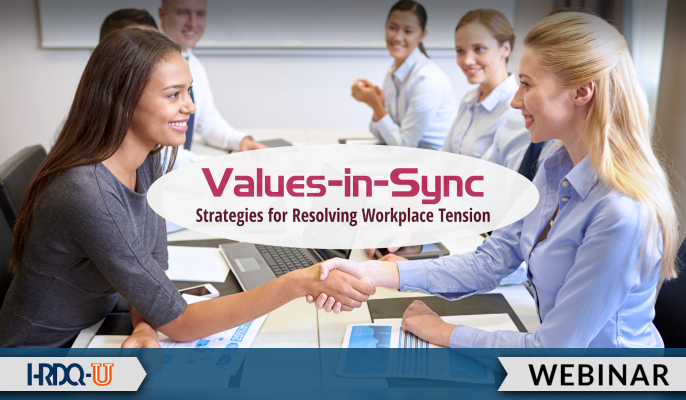- 827 Lincoln Ave. #B-10 West Chester, PA 19380
- support@hrdq.com
- +1-610-279-2002
Quick Links
Menu
Featured Topics
Menu
Total Results
We could not find what you're looking for. Please try again.No Record Found

Human Resource professionals are the heartbeat of an organization as they are responsible for shaping the culture of the organization and helping the values come alive. As primary influencers, members of the HR team are particularly important in ensuring team members from the C-suite to the newest employee live into the values of the organization – that the values of all are in sync.
The culture of an organization is determined by how well – or poorly – people live into the stated values. EthicsGame’s work shows that values come in tension with each other when various stakeholders have different understandings of what behaviors count for living according to the stated values. When confronted with inevitable differences in intentions and expectations, people become frustrated and accuse each other of being unethical, and the culture turns toxic. This workshop will explore the root causes of value conflicts and then explore effective methods for resolution.
The first opportunity for the misalignment of values comes during the hiring and onboarding process. From ensuring that the company’s DEI initiatives are met through supporting people in harmonizing their personal values with those of the organization, an awareness of the different behaviors that count for living according to the values is key. Employee engagement begins with the new hires becoming clear about what behaviors are expected of them and what reciprocal behaviors they can expect from others arising from a commitment to shared values.
A second source of tension comes when people have either overdeveloped or underdeveloped expressions of core values. For example, companies know that policies of inclusion will help employees be more engaged and support diversity initiatives. Someone with an underdeveloped sense of inclusion might assume that anyone who wants to participate can, so they make no particular effort to reach out to others. Someone with an overdeveloped sense of inclusion might assume that they can lead anyone effectively, so they don’t kick anyone off the team, even if that member doesn’t contribute. This webinar will explore how an attentive HR professional can recognize and then address situations where people are not expressing their values appropriately.
A final source of tension comes when the systems in place for evaluation, promotion, and perks become an inadvertent barrier to the full expression of organizational values. Often, individuals are blamed for a toxic culture when, in fact, the processes for supporting employee growth and contribution are flawed. For example, people may not be thoughtful about who gets sponsored for a promotion, or processes for advancement may only filter through select employee networks. We will explore the differences between systemic barriers to values being in sync and individuals thwarting that intention and then evaluate different strategies for resolution.
Every strategy for resolving values in tension begins with recognizing the ethical foundations informing values, beliefs, and behaviors. The workshop will explore the four different ways that values are expressed, the behaviors that flow from the different expectations, and the impact on the culture. As HR professionals become aware of those differences, they can mirror divergent expressions of values and communicate effectively to ensure all are focused on the mission of the organization, not the idiosyncrasies of individuals or the culture.


Catharyn Baird, JD, is the Founder/CEO of EthicsGame, LLC and emerita professor of business at Regis University in Denver, CO. Baird’s research resulted in the development of the Ethical Lens Inventory™, a typology used by more than 575,000 people to determine their ethical preference and leadership style. Her research is also foundational to the family of simulations based on an experiential and organic approach to ethical decision-making. The approach was published in Everyday Ethics: Making Wise Choices in a Complex World, 2nd ed. (2012) and with Jeannine Niacaris, The Ethical Self, 2nd ed. (2021).
EthicsGame’s newest publication is Values-in-Sync Card Deck, which provides HR professionals with a toolbox for creating a values-focused culture. Baird was featured as a TEDxMileHi 2015: Ideas Unbridled presenter with her presentation, Ethics for People on the Move. EthicsGame’s leading-edge pedagogy was featured in the January/February 2013 BizEd. Baird is widely published in ethics, with recent articles in the Business and Society Review (2021) and the Journal of Business Ethics (2020).
Baird received her BA in English, MA in humanities, and teacher’s certification from Pacific University. She attended the University of Puget Sound (now Seattle University) school of law.
Connect with Catharyn on Facebook, Twitter, and at www.ethicsgame.com.
Training Tools for Developing Great People Skills
This event is sponsored by HRDQ. For 45 years HRDQ has provided research-based, off-the-shelf soft-skills training resources for classroom, virtual, and online training. From assessments and workshops to experiential hands-on games, HRDQ helps organizations improve performance, increase job satisfaction, and more.
Learn more at HRDQstore.com

“Very good insights and presented in an excellent way.”
Humberto S.
Trainer

“Good info – well-structured presentation and excellent Q/A session. Thanks a million!”
Barbara S.
Program Management Specialist

“It was wonderful.”
Duncan S.
Facilitator

Sign up to be notified of upcoming live webinars, in-depth workshops, podcasts, blog posts, promotions and much more. Stay ahead of the curve and subscribe for FREE today!